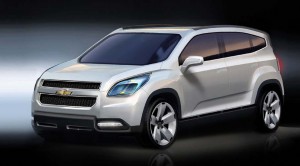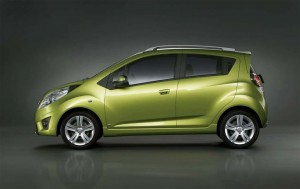
The Chevrolet Orlando, shown here in concept form, is deceptive. Despite its small footprint it will offer three-row seating for up to seven.
At first glance, the challenge seems daunting. Going into bankruptcy court, earlier this year, General Motors ran eight unique North American brands. Today it has just four, yet it’s hoping to maintain most of its sales and market share and even build momentum in the coming years.
To accomplish that feat, the long-troubled automaker is counting on its Chevrolet brand to do the heavy lifting. “Chevy will account for over 70% of GM sales” in North America, said the marque’s new general manager, Jim Campbell.”
Pulling that off won’t be easy. As senior company officials, all the way up to Acting CEO Ed Whitacre admit, there’s a sizable share of U.S. buyers who are not just indifferent but in many cases downright hostile to General Motors.
“I’m worried about what people think of us and how to get them to trust us,” acknowledged Mark Reuss, the newly-appointed president of GM’s North American operations.

Initially, GM had no plans to market the Korean-designed Chevrolet Spark in the U.S., but with growing demand for high-mileage vehicles, it will shore up the low end of the Chevy line-up.
If there’s one way to get that message across, Reuss, Campbell and Whitacre agree, it’s by delivering the sort of stand-out product that was missing from the GM line-up for all too many years. It helps, of course, to get third-party endorsements, and they’ve been coming in increasing numbers. The current version of the Chevy Malibu was named North American Car of the Year, in 2008, and has landed on the Recommended Buy list of influential Consumer Reports magazine.
But during a background session, Chevy pulled the wraps off an all-new version of the Malibu, along with an assortment of other new products that will be joining the brand’s line-up over the next two years. While photography was not permitted during the session, here’s a quick summary of the most significant models:
- The next-generation Malibu boasts a notably more sculpted design than the current edition, the body nearly matching the aero efficiency of the Volt plug-in hybrid. But it shares what might be described as the Chevy “family face,” the now-familiar grille framing the classic bowtie brand logo. The rear, meanwhile, should be equally familiar, as all new Chevy products will feature twin taillights, whether positioned vertically or horizontally. The interior, meanwhile, is even more lavishly finished than today’s model and picks up another Chevy cue, a twin-cockpit layout.
- The eagerly-awaited Chevy Camaro Convertible is finally coming to market after an unanticipated delay when the original ragtop supplier went broke. The power top is taut and designed to look much like the coupe when in place. In a segment where buyers constantly demand fresh design, the Convertible should keep Camaro’s momentum going.
- The Spark was one of three prototypes, collectively known as The Triplets, and was chosen in a public vote. It’s one of Chevy’s critical new offerings aimed at the youth market. The most striking – if controversial feature is the hatchback’s headlights, which run nearly a third of the minicar’s total length. The dual cockpit has a surprisingly rich and high-tech feel, but with a 40 mpg Highway rating, fuel economy will be a clear selling point.
- The slightly larger Aveo sedan is slightly larger and definitely more visually appealing than the old econobox. It will be offered in both hatchback and notchback body styles. The hatch’s distinctive feature line gives it a sporty and elegant feel. “It no longer looks like an econobox,” asserts designer Mike Simcoe. An interesting detail is the way the rear door handles are hidden on the hatchback.
- The much-delayed Cruze is finally about to roll into U.S. showrooms, about a year after the car staged a strong launch in Europe. Compact in designation, it boasts a near-midsize passenger compartment. Safety is a strong point, with five-star crash ratings and 10 airbags, but with a Turbo inline-four engine delivering up to 40 mpg, fuel economy will be a big selling point for Cruze, as well.
- The Orlando crossover-utility vehicle, or CUV, takes aim at a new segment that might be described as the box-mobile. The very upright design might fit into the compact category yet the deceptive design makes room for three rows and up to seven passengers. “This is really not your mom’s minivan,” insists designer Simcoe. Interesting design touches abound, including a radio face plate that flips up to reveal a useful center stack storage box.
Will these and other new models help win back skeptical American car buyers? Perhaps the biggest problem, says analyst Stephanie Brinley, of AutoPacific Inc., “is that I’d rather have them sooner than later. But I like what we saw. I like the way they’re applying the Chevy face yet still finding ways to make the cars look different, sometimes dramatically so.”
It’ll take time to see how if the public agrees, and considering GM’s recent financial problems, Chevy won’t have time for any re-dos if the upcoming line-up doesn’t click. But there’s a new level of design elegance and refinement to the brand’s products that could make it stand out after years of being lost in the crowd.
